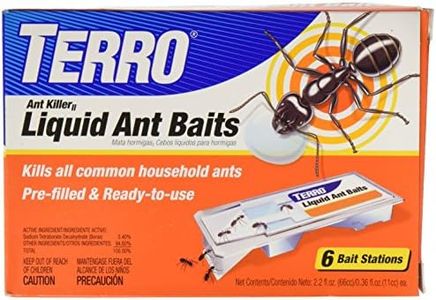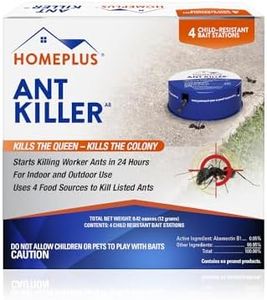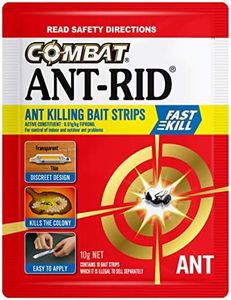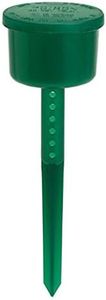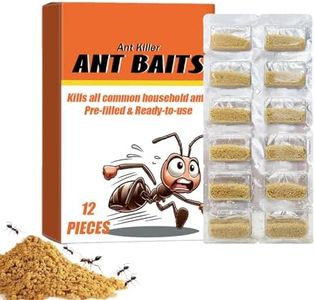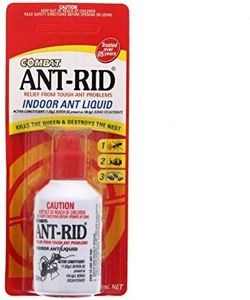We Use CookiesWe use cookies to enhance the security, performance,
functionality and for analytical and promotional activities. By continuing to browse this site you
are agreeing to our privacy policy
10 Best Carpenter Ant Baits
From leading brands and best sellers available on the web.Buying Guide for the Best Carpenter Ant Baits
When choosing carpenter ant baits, it's important to find a solution that effectively attracts and eliminates the ants causing trouble in your home or property. Carpenter ants can be quite persistent and damaging, so picking the right bait ensures the colony is targeted and the problem is solved at its source. The effectiveness of your bait depends on factors like the type of bait, placement, safety, and how quickly you need results. Understanding key features will help you select a bait that matches your situation and environment.Active IngredientThe active ingredient is the main chemical or natural compound in the bait that actually kills the ants. Common types include borax, abamectin, hydramethylnon, and other insecticides. This is important because different ingredients work in different ways: some act slowly to allow the ants to take bait back to the colony, while others kill quickly but might not reach the whole nest. If you want complete colony elimination, look for slow-acting ingredients, especially if you notice lots of ant activity. For faster results on visible ants, quick-acting ingredients might suit you. Always check labels for environmental and safety information, especially if there are pets or children around.
Bait FormulationBait formulation describes how the bait is presented—gels, liquids, solids, granules, or bait stations. Liquid and gel baits are often best for indoor use or where ants are frequently seen, as they closely mimic the food ants like. Granules can be scattered outdoors or in hard-to-reach areas. Bait stations are enclosed and prevent children or pets from direct contact, making them safer for home environments. The right formulation depends on where you see the ants and how you want to control access. For indoor problems, gels and pre-filled stations work well. Outdoor issues or larger areas might be better handled with granules.
Attractiveness to AntsThis spec refers to how appealing the bait is to carpenter ants. Carpenter ants can be picky eaters, with preferences that change based on the time of year and colony needs—sometimes they want sweet, other times protein or fat-based baits. This matters because even the strongest bait won't work if ants ignore it. Some baits are made to be more universally attractive, while others are targeted for either sweet or protein needs. Notice what the ants are foraging for before buying; if they go for sugary items in your home, choose a sweet bait; if they like greasy foods or protein, opt for a protein-based bait.
Indoor vs Outdoor UseIndoor vs outdoor use tells you where the bait is intended to work best. Indoor baits are made to be safe and less odorous, while outdoor baits may be weather-resistant and stronger to handle the harsher environment. Matching bait location to your ant problem is essential. If ants are mostly inside, choose a bait labeled safe for indoor use, paying attention to safety with children or pets. For ant trails, nests, or mounds outside, opt for outdoor-approved products—these will hold up better to rain or wind.
Safety and Non-target ImpactSafety and non-target impact addresses how likely the bait is to affect people, pets, or other wildlife not intended to be controlled. Some ingredients are low in toxicity, while others require more care in handling and placement. If you have young children, pets, or garden wildlife you want to protect, pick baits labeled as low-toxicity or that use enclosed bait stations. Always follow label directions for placement and disposal to keep everyone safe while solving your ant problem.
Speed of ResultsSpeed of results means how quickly you can expect to see ant activity decrease. Some baits are designed for fast action, killing ants within hours, while others work slowly to ensure that bait is shared with the colony, often taking days or even weeks. If you need immediate relief (say for a kitchen infestation), you might prefer a faster-acting bait. But for longer-term, colony-level control, opt for a slow-acting bait that allows ants to take it back to the nest.
